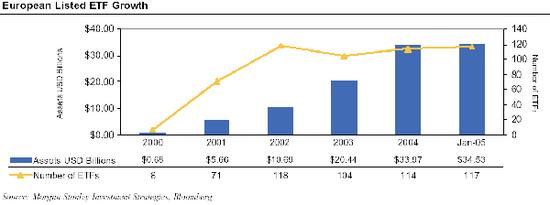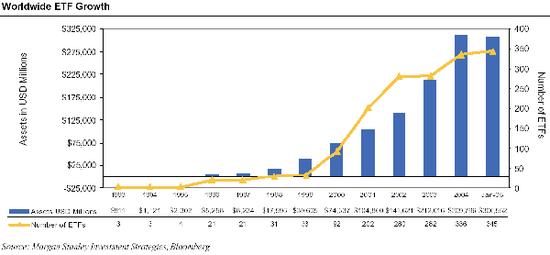|
|
Friday, 19th December 2025 |
| First Irish exchange-traded fund opens up new market for Irish investors |
Back |
| Exchange Traded Funds (ETF) have taken the world’s financial markets by storm in recent years with billions currently invested in a range of funds spanning all the major global stock markets. And now, for the first time, an ETF that has been designed to track the performance of the Irish equity market is about to be launched on the Irish Stock Exchange, writes Peter Duff. |
As the name suggests, Exchange Traded Funds (ETFs) are investment funds that are traded on a recognised exchange such as a stock market. Generally speaking, the investment objective of these funds is to invest in a specified index or basket of individual shares. In so doing, ETFs provide investors with access to a diversified portfolio of shares through one single transaction. In the past, investors have only been able to access this form of pooled equity investment through a unit-linked fund/trust or, in the case of the US market, a mutual fund.
 | | European Listed ETF Growth |
ETFs have enjoyed huge success internationally in recent years as investors have been attracted by the lower risk and cost profile of the product, as well as the ease of dealing. ETFs, which were launched in the US in 1993, are now worth over $300 billion globally. The first ETF linked to the performance of the Irish equity is soon to be listed on the ISEQ.
ETFs are simple, low cost and flexible products that combine the ready-made diversification of index tracking with the ease and liquidity features of quoted shares.
ETFs also offer far more choices than traditional index linked unit funds. Apart from tracking the major indices, ETFs have been created to track specific market sectors as well as baskets of top stocks and even key commodities. Key features of ETFs include:
Structured like a fund
• Basket of stocks that provides diversification/spread of risk.
• Attempts to closely track a widely accepted benchmark such as an index.
• Details set out in a prospectus.
Traded like a stock
• Trades like any quoted share listed on a stock exchange
• Price updates throughout the trading day
• Can be sold short
Institutions account for the majority of ETF investors and the growing volume of dealing in ETF shares, although they are becoming increasingly popular among retail investors.
 | | Worldwide ETF Growth |
ETFs are used by pension funds and other professional investors for a multitude of portfolio management purposes, including providing access to markets and sectors, which would otherwise be difficult to achieve in a simple and cost effective manner.
In other cases, ETFs are used to equitise cash or to establish an over or underweight position in a particular market or sector.
Settlement and administration are straightforward. Where dividends are payable, they will generally be distributed on a semi-annual basis.
Also, unlike some investment funds, which can trade at a significant premium or discount to net asset value (the value of the underlying holdings), ETFs tend to trade close to NAV.
Key attractions
Simplicity: ETFs are funds that track the performance of a particular index and whose shares are quoted on a stock market. Similar to traditional unit-linked funds, new shares can be created and redeemed daily, but usually only by institutions or designated market makers in large blocks. Most retail investors will buy and sell ETF shares in the secondary market, just like most other quoted equities.
Liquidity: Because ETF shares trade like stocks they offer intra-day liquidity. That means that they can be bought and sold at any time during stock exchange hours. This compares to unit-linked funds, which are generally bought and sold at a price equal to the closing Net Asset Value (NAV). This can be a daily price, weekly price or monthly price, depending on the nature of the fund.
Given the increasingly volatile nature of equity markets over recent years, this intra-day trading capability is an important advantage. Investors can also apply limits to their orders, thereby providing additional downside protection.
Costs: ETFs offer a lower cost structure than traditional unit-linked funds. ETFs have total expense ratios - a measure of the cost of investing in them - of between 0.25 and 0.75 per cent. This compares with an average of 1.50 per cent for a typical fund product. Like equities, commission is payable on the purchase and sale of ETFs.
Diversification: ETFs offer investors the scope to diversify their equity exposure through an instrument with all the features and advantages of a quoted stock but without the concentrated risks associated with individual stocks.
More efficient portfolio management
ETFs allow individual investors more freedom in personalizing their own portfolios. Instead of merely buying, say, the S&P 500 as a means of gaining broad equity exposure to the US market, investors can use ETFs to, for example, overweight preferred sectors (Semiconductors Vs Financials), management styles (Growth Vs Value) or large/mid-cap stocks. As more ETFs come to market, the choices will expand.
Transparency
Like other equities, ETF price movements are recorded on the relevant stock exchange and can generally be accessed daily in newspapers on intra-day on designated web sites. |
Peter Duff is head of product development at NCB Stockbrokers.
|
| Article appeared in the March 2005 issue.
|
|
|